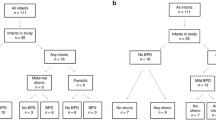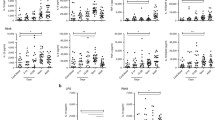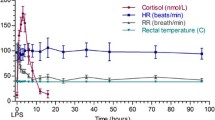Abstract
Newborn calves, like human infants, are uniquely susceptible to bacterial infections. Part of this increased susceptibility may be related to defects in newborn polymorphonuclear leukocyte (PMN) defensive functions. It remains unclear whether reported deficits in newborn PMN function represent maturational disorders or are manifestations of some form of perinatal suppression phenomenon. We therefore compared the ability of bovine newborn PMNs (less than 24 h old), newborn PMNs (7–10 days of age), fetal PMNs (210–220 days gestational age), and adult PMNs to generate superoxide anion (O −2 ) as an indicator of respiratory burst activity. Citrated biood was collected, and PMNs were isolated to greater than 95% purity and 98% viability. O −2 generation was measured as the superoxide dismutase-inhibitable (10 μg/ml) reduction of ferricytochrome c (2 mg/ml) after activation of PMNs with phorbol myristate acetate (PMA, 2 μg/ml) to directly stimulate protein kinase C. The reaction kinetics were measured (37°C, 550 nm) using a spectrophotometer and chart recorder for continuous monitoring. O −2 generation was measured for 5 min after the initial lag period and the total nanomoles of O −2 generated calculated using the extinction coefficient for ferricytochromec. Newborn PMNs (N=10) generated significantly less O −2 (5.7 ±0.8 nmol O −2 /106 cells/5 min,P < 0.01) than did adult PMNs (N=14) (9.6 ±2.1 nmol O −2 /1010 cells/5 min) or fetal PMNs (N=4) (10.7 ±0.7 nmol O −2 /106 cells/5 min). PMNs from 7-to 10-day-old calves (N=9) generated almost identical amounts of O −2 as newborn PMNs (5.7 ±1.6 nmol O −2 /106 ceils/5 min). There was no difference in measured lag time period between new-born and adult PMNs, but fetal PMNs had significantly reduced (P < 0.01) mean lag time. The data indicated that bovine newborn PMNs have a decreased ability to generate O −2 in response to PMA stimulation, which persists for at least 7–10 days, and that this functional decrement may be a manifestation of some form of perinatal PMN suppression phenomenon rather than a developmental abnormality since fetal PMNs produced O −2 as well as adult PMNs.
Similar content being viewed by others
References
Faden, H., andS. Rosales. 1984, Infections in the compromised neonate.In Neonatal Infections: Nutritional and Immunologic Interactions. P. L. Ogra, editor. Grune & Stratton, Orlando, Florida. 185–202.
Medici, M. A., C. T. Ukrainski, andR. A. Gatti. 1979. The neonatal inflammatory response.In Pediatric Immunology. H. Hodes and B. M. Kagen, editors. Science and Medicine Publ., New York. 89–111.
Bortolussi, R. 1984. Host defense mechanisms to perinatal and neonatal infection.Survey Synth. Pathol. Res. 3:311–328.
Banks, K. L. 1982. Host defense in the newborn animal.J. Am. Vet. Med. Assoc. 181:1053–1056.
Bryson, D. G., J. B. McFerran, H. J. Ball, andS. D. Neill. 1978. Observations on out-breaks of respiratory disease in housed calves. 1. Epidemiological, clinical and microbiological findings.Vet. Rec. 103:485–489.
Bryson, D. G., J. B. McFerran, H. J. Ball, andS. D. Neill, 1978. Observations on out-breaks of respiratory disease in housed calves. 2. Pathological and microbiological findings.Vet. Rec. 103:503–509.
Irwin, V. C. 1974. Incidence of disease in colostrum-deprived calves.Vet. Rec. 94:105–106.
Martinez, M., A. E. Freeman, andP. J. Berger. 1983. Factors affecting calf livability for Holsteins.J. Dairy Sci. 66:2400–2407.
McGuire, T. C., N. E. Pfeiffer, J. M. Weikerl, andR. G. Bartsch. 1976. Failure of colostral immunoglobulin transfer in calves dying from infectious disease.J. Am. Vet. Med. Assoc. 169:713–716.
Rosenquist, B. D., andA. W. Dobson. 1974. Multiple viral infections in calves with acute bovine respiratory tract disease.Am. J. Vet. Res. 35:363–365.
Martin, S. W., C. W. Schwabe, andC. E. Franti. 1975. Dairy calf mortality rate: Characteristics of calf mortality rates in Tulare County, California.Am. J. Vet. Res. 36:1099–1104.
Speer, C. P., andR. B. Johnston, Jr. 1984. Phagocyte function.In Neonatal Infections: Nutritional and Immunologic Interactions. P. L. Ogra, editor. Grune & Stratton, Orlando, Florida. 21–36.
Hill, H. R. 1987. Biochemical, structural, and functional abnormalities of polymorphonuclear leukocytes in the neonate.Pediatr. Res. 22:375–382.
Miller, M. E. 1971. Chemotactic function in the human neonate: humoral and cellular aspects.Pediatr. Res. 5:487–492.
Anderson, D. C., B. J. Hughes, andC. W. Smith. 1981. Abnormal motility of neonatal polymorphonuclear leukocytes: Relationship to impaired redistribution of surface adhesion sites by chemotactic factor or colchicine.J. Clin. Invest. 68:863–874.
Anderson, D. C., B. J. Hughes, L. J. Wible, G. J. Perry, C. W. Smith, andB. R. BrinkLey. 1984. Impaired motility of neonatal PMN leukocytes: Relationship to abnormalities of cell orientation and assembly of microtubules in chemotactic gradients.J. Leukocyte Biol. 36:1–15.
Christensen, R. D., andG. Rothstein. 1980. Efficiency of neutrophil migration in the neonate.Pediatr. Res. 14:1147–1149.
Chirico, G., M. Marconi, M. Deamici, A. Gasparoni, andG. Mingrat. 1985. Deficiency of bactericidal activity in term and premature infants: A longitudinal study.Biol. Neonate 47:125–129.
Mease, A. D., G. W. Fischer, K. W. Hunter, andF. B. Ruymann. 1980. Decreased phy-tohemagglutinin-induced aggregation and C5a-induced chemotaxis of human newborn neutrophils.Pediatr. Res. 14:142–146.
Mease, A. D., D. P. Burgess, andP. J. Thomas. 1981. Irreversible neutrophil aggregation: A mechanism of decreased newborn neutrophil chemotactic response.Am. J. Palhol. 104:98–102.
Harris, M. C., J. Stroobant, C. S. Cody, S. D. Douglas, andR. A. Polin. 1983. Phagocytosis of Group B Streptococcus by neutrophils from newborn infants.Pediatr. Res. 17:358–361.
Marodi, L., P. C. J. Leijh, andR. van Furth. 1984. Characteristics and functional capacities of human cord blood glanulocytes and monocytes.Pediatr. Res. 18:1127–1131.
Olson, T. A., F. B. Ruyman, B. A. Cook, D. P. Burgess, S. A. Henson, andP. J. Thomas. 1983. Newborn polymorphonuclear leukocyte aggregation: A study of physical properties and uitrastructure using chemotactic peptides.Pediatr. Res. 17:993–998.
Mills, E. L., T. Thompson, B. Bjorksten, D. Filipovich, andP. G. Quie. 1979. The chemiluminescence response of bactericidal activity of polymorphonuclear neutrophils from newborns and their mothers.Pediatrics 63:429–434.
Wright, W. C., Jr., B. J. Ank, J. Hebert, andE. R. Stiehm. 1975. Decreased bactericidal activity of leukocytes from stressed newborn infants.Pediatrics 56:579–584.
Rider, E. D., R. D. Christensen, D. C. Hall, andG. Rothstein. 1988. Myeloperoxidase deficiency in neutrophils of neonates.J. Pediatr. 112:648–651.
Park, B. H., B. Holmes, andR. A. Good. 1970. Metabolic activities in leukocytes of newborn infants.J. Pediatr. 76:237–241.
Ambruso, D. R., K. M. Altenberger, andR. B. Johnston, Jr. 1979. Defective oxidative metabolism in newborn neutrophils: discrepancy between superoxide anion and hydroxyl radical generation.Pediatrics 64:722–725.
Strauss, R. G., andE. L. Snyder. 1983. Activation and activity of the superoxide generating system of neutrophils from human infants.Pediatr. Res. 17:662–664.
Yamazaki, M., T. Matsuoka, K. Yasut, A. Komiyama, andT. Akabane. 1988. Increased production of superoxide anion by neonatal polymorphonuclear leukocytes stimulated with a chemotactic peptide.Am. J. Hematol. 27:169–173.
Ambruso, D. R., L. C. Stork, B. E. Gibson, andG. W. Thruman. 1987. Increased activity of the respiratory burst in cord blood neutrophils: kinetics of the NADPH oxidase enzyme system in subcellular fractions.Pediatr. Res. 21:205–210.
Ambruso, D. R., B. Bentwood, P. M. Henson, andR. B. Johnston, Jr. 1984. Oxidative metabolism of or cord blood neutrophils: Relation to content and degranulation of cytoplasmic granules.Pediatr. Res. 18:1148–1153.
Bellanti, J. A., B. E. Cantz, M. C. Yaxg, H. Von Thadden, andR. J. Schlegel. 1975. Biochemical changes in human polymorphonuclear leukocytes during maturation.In The Phagocytic Cell in Host Resistance. J. A. Bellanti and D. H. Dayton, editors. Raven Press, New York. 321–329.
Strauss, R. G., T. G. Rosenberger, andP. D. Wallace. 1980. Neutrophil chemilumi-nescence during the first month of life.Acta Haematol. 63:326–330.
Van Epps, D. E., J. S. Goodwin, andS. Murphy. 1978. Age-dependent variations in polymorphonuclear leukocyte chemiluminescence.Infect. Immun. 22:57–61.
Peden, D. B., K. Van Dyke, A. Ardekani, M. D. Mullett, D. Z. Myerberg, andC. Van Dyke. 1987. Diminished chemiluminescent responses of polymorphonuclear leukocytes in severely and moderately premature infants.J. Pediatr. 111:904–906.
Zwahlen, R. D., D. O. Slauson, N. R. Neilsen, andC. B. Clifford. 1987. Increased adhesiveness of complement-stimulated neonatal calf neutrophils and its pharmacologic inhibition.J. Leukocyte Biol. 41:465–473.
Hauser, M. A., M. D. Koob, andJ. A. Roth. 1986. Variation of neutrophil function with age in calves.Am. J. Vet. Res. 47:152–153.
Hill, H. R. 1985. Host defense in the neonate: prospects for enhancement.Semin. Perinatal. 9:2–11.
Newburger, P. E. 1976. Superoxide generation by human fetal granulocytes.Pediatr. Res. 16:373–376.
Rotrosen, D., andJ. I. Gallin. 1987. Disorders of phagocyte function.Annu. Rev. Immunol. 5:127–150.
Forman, H. J., andM. J. Thomas. 1986. Oxidant production and bactericidal activity of phagocytes.Annu. Rev. Physiol. 48:669–680.
Pross, S. H., J. A. Hallock, R. Armstrong, andC. W. Fishel. 1977. Complement and Fc receptors on cord blood and adult neutrophils.Pediatr. Res. 11:135–137.
Osburn, B. I. 1981. The ontogeny of the ruminant immune system and its significance in the understanding of matemal-fetal-neonatal relationships. The ruminant immune system.Adv. Exp. Med. Biol. 137:91–103.
Bruce, M. C., J. E. Baley, K. A. Medvik, andM. Berger. 1987. Impaired surface membrane expression of C3bi but not C3b receptors on neonatal neutrophils.Pediatr. Res. 21:306–311.
Wolfson, M., L. C. McPhail, V. N. Nasrallah, andR. Snyderman 1985. Phorbol my ristate acetate mediates redistribution of protein kinase C in human neutrophils: Potential role in the activation of the respiratory burst enzyme.J. Immunol. 135:2057–2061.
Tauber, A. I. 1987. Protein kinase C and the activation of the human neutrophil NADPH-oxidase.Blood 69:711–720.
Johnston, R. B., C. A. Godzik, andZ. Cohn. 1978. Increased superoxide anion production by immunologically activated and chemically elicited macrophages.J. Exp. Med. 148:115–127.
Hollander, M., andD. Wolfe. 1973. Nonparametric Statistical Methods. John Wiley & Sons, New York. 115.
Zeligs, B. J., andJ. A. Bellanti. 1988. Inflammatory influx and oxidative burst components during postnatal development.Pediatr. Res. 23:463A.
Thorburn, G. D., andJ. R. G. Challis. 1979. Endocrine control of parturition.Physiol. Rev. 59:863–918.
Eberhart, R. J., andJ. A. Patt. 1971. Plasma cortisol concentrations in newborn calves.Am. J. Vet. Res. 32:1921–1927.
Roth, J. A., M. L. Kaeberle, andW. Hsu. 1982. Effects of ACTH administration on bovine polymorphonuclear leukocyte function and lymphocyte blastogenesis.Am. J. Vet. Res. 43:412–416.
Henricks, P. A. J., G. J. Binkhorst, andF. P. Nijkamp. 1987. Stress diminishes infiltration and oxygen metabolism of phagocytic cells in calves.Inflammation 11:427–437.
Krause, P., H. Malkech, J. Kristie, C. M. Kosciol, V. C. Herson, L. Eisenfeld, W. T. Pastuszak, A. Kraus, andB. Seligman. 1986. Polymorphonuclear leukocyte heterogeneity in neonates and adults.Blood 68:200–204.
Berkow, R. L., andR. W. Dodson. 1987. Functional analysis of the marginating pool of human polymorphonudear leukocytes.Am. J. Hematot. 24:47–54.
Author information
Authors and Affiliations
Rights and permissions
About this article
Cite this article
Clifford, C.B., Slauson, D.O., Neilsen, N.R. et al. Ontogeny of inflammatory cell responsiveness. Inflammation 13, 221–231 (1989). https://doi.org/10.1007/BF00924792
Issue Date:
DOI: https://doi.org/10.1007/BF00924792




